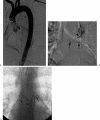Bronchial artery embolization for hemoptysis
- PMID: 22379276
- PMCID: PMC3140255
- DOI: 10.1055/s-0031-1273940
Bronchial artery embolization for hemoptysis
Abstract
Bronchial artery angiography with embolization has become a mainstay in the treatment of hemoptysis. Major complications are rare and immediate clinical success defined as cessation of hemorrhage ranges in most series from 85% to 100%, although recurrence of hemorrhage ranges from 10% to 33%. Bronchial artery embolization offers a minimally invasive procedure for even the most compromised patient serving as first-line treatment for hemorrhage as well as providing a bridge to more definitive medical or surgical intervention focused upon the etiology of the hemorrhage. The aim of this article is to summarize the etiologies, pathophysiology, and the diagnostic and management strategies of hemoptysis as related to bronchial artery embolization. In addition, the techniques of arteriography and embolization as well as associated procedural outcomes and complications are delineated.
Keywords: Hemoptysis; angiography; arterial embolization; bronchial artery.
Figures









Similar articles
-
Bronchial artery embolization for massive hemoptysis: long-term follow-up.Asian Cardiovasc Thorac Ann. 2015 Jan;23(1):55-60. doi: 10.1177/0218492314544310. Epub 2014 Jul 22. Asian Cardiovasc Thorac Ann. 2015. PMID: 25053662
-
Bronchial artery embolization. What further we can offer?Wideochir Inne Tech Maloinwazyjne. 2020 Sep;15(3):478-487. doi: 10.5114/wiitm.2019.89832. Epub 2019 Nov 18. Wideochir Inne Tech Maloinwazyjne. 2020. PMID: 32904618 Free PMC article.
-
Bronchial Artery Embolization, an Increasingly Used Method for Hemoptysis; Treatment and Avoidance.Sisli Etfal Hastan Tip Bul. 2020 Aug 25;54(3):313-319. doi: 10.14744/SEMB.2020.68870. eCollection 2020. Sisli Etfal Hastan Tip Bul. 2020. PMID: 33312029 Free PMC article.
-
Bronchial Artery Embolization for the Treatment of Acute Hemoptysis.Tech Vasc Interv Radiol. 2017 Dec;20(4):263-265. doi: 10.1053/j.tvir.2017.10.006. Epub 2017 Oct 9. Tech Vasc Interv Radiol. 2017. PMID: 29224659 Review.
-
Radiological management of hemoptysis: a comprehensive review of diagnostic imaging and bronchial arterial embolization.Cardiovasc Intervent Radiol. 2010 Apr;33(2):240-50. doi: 10.1007/s00270-009-9788-z. Cardiovasc Intervent Radiol. 2010. PMID: 20058006 Review.
Cited by
-
Outcomes of bronchial artery embolization for life-threatening hemoptysis secondary to tuberculosis.PLoS One. 2014 Dec 26;9(12):e115956. doi: 10.1371/journal.pone.0115956. eCollection 2014. PLoS One. 2014. PMID: 25541693 Free PMC article.
-
Haemoptysis due to an atypical right bronchial artery branching from the left subclavian artery evaluated by four-dimensional CT and bronchial arteriography.BMJ Case Rep. 2021 Mar 10;14(3):e239754. doi: 10.1136/bcr-2020-239754. BMJ Case Rep. 2021. PMID: 33692054 Free PMC article.
-
Angiographic Findings and Outcomes of Bronchial Artery Embolization in Patients with Pulmonary Tuberculosis.Eurasian J Med. 2020 Jun;52(2):126-131. doi: 10.5152/eurasianjmed.2020.19221. Epub 2020 Jun 2. Eurasian J Med. 2020. PMID: 32612418 Free PMC article.
-
Feasibility and safety of uniportal thoracoscopy for chronic pulmonary aspergillosis.Sci Rep. 2023 Sep 30;13(1):16480. doi: 10.1038/s41598-023-43781-9. Sci Rep. 2023. PMID: 37777661 Free PMC article.
-
A retrospective analysis of 334 cases of hemoptysis treated by bronchial artery embolization.Oman Med J. 2015 Mar;30(2):119-28. doi: 10.5001/omj.2015.26. Oman Med J. 2015. PMID: 25960838 Free PMC article.
References
-
- Haponik E F, Fein A, Chin R. Managing life-threatening hemoptysis: has anything really changed? Chest. 2000;118(5):1431–1435. - PubMed
-
- Shigemura N, Wan I Y, Yu S C, et al. Multidisciplinary management of life-threatening massive hemoptysis: a 10-year experience. Ann Thorac Surg. 2009;87(3):849–853. - PubMed
-
- Wyngaarden J B, Smith L H, Bennett J C. Cecil Textbook of Medicine. 19th ed. Philadelphia: WB Saunders; 1992. p. 370.
-
- Crocco J A, Rooney J J, Fankushen D S, DiBenedetto R J, Lyons H A. Massive hemoptysis. Arch Intern Med. 1968;121(6):495–498. - PubMed
-
- Ferris E J. Pulmonary hemorrhage. Vascular evaluation and interventional therapy. Chest. 1981;80(6):710–714. - PubMed

